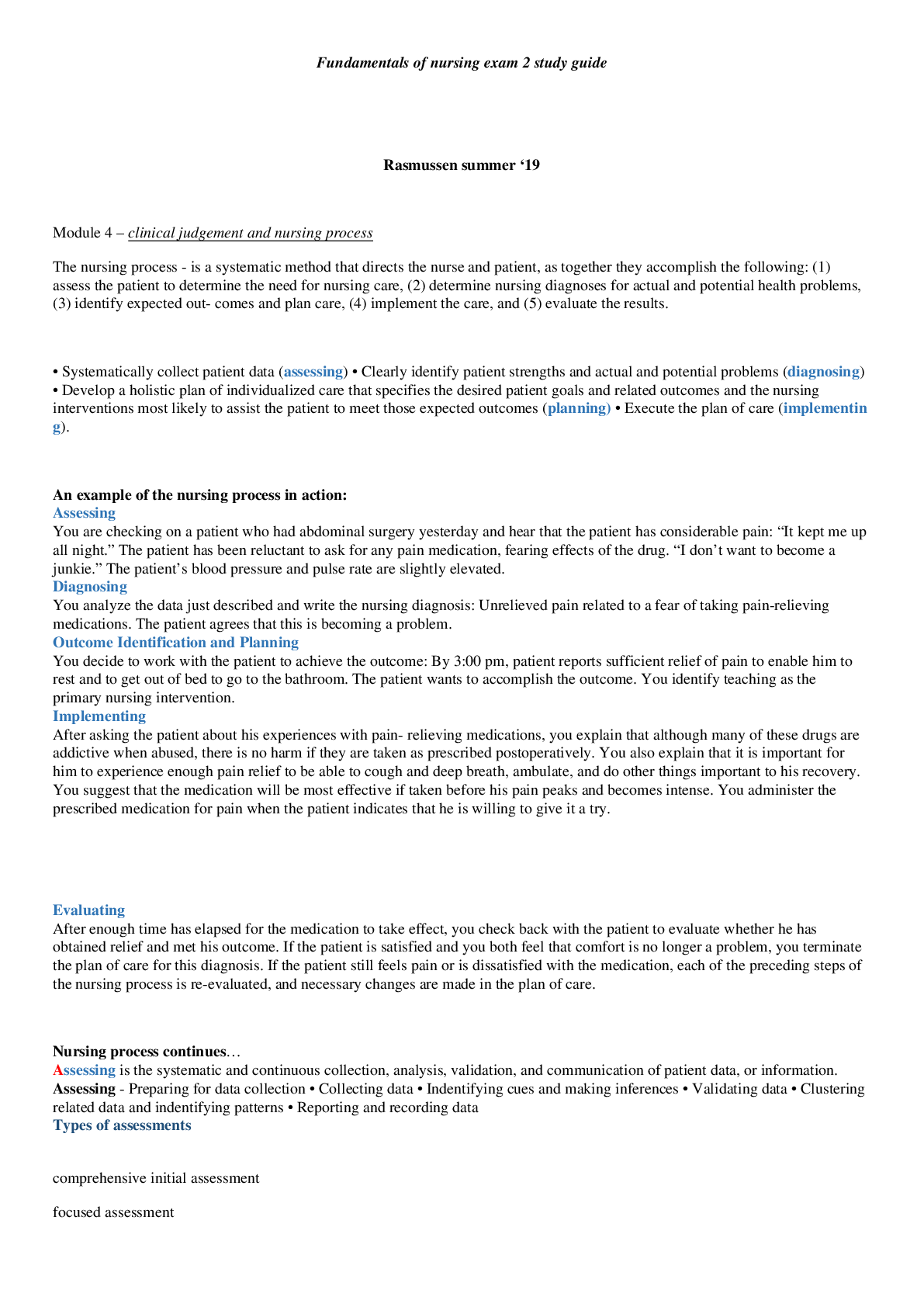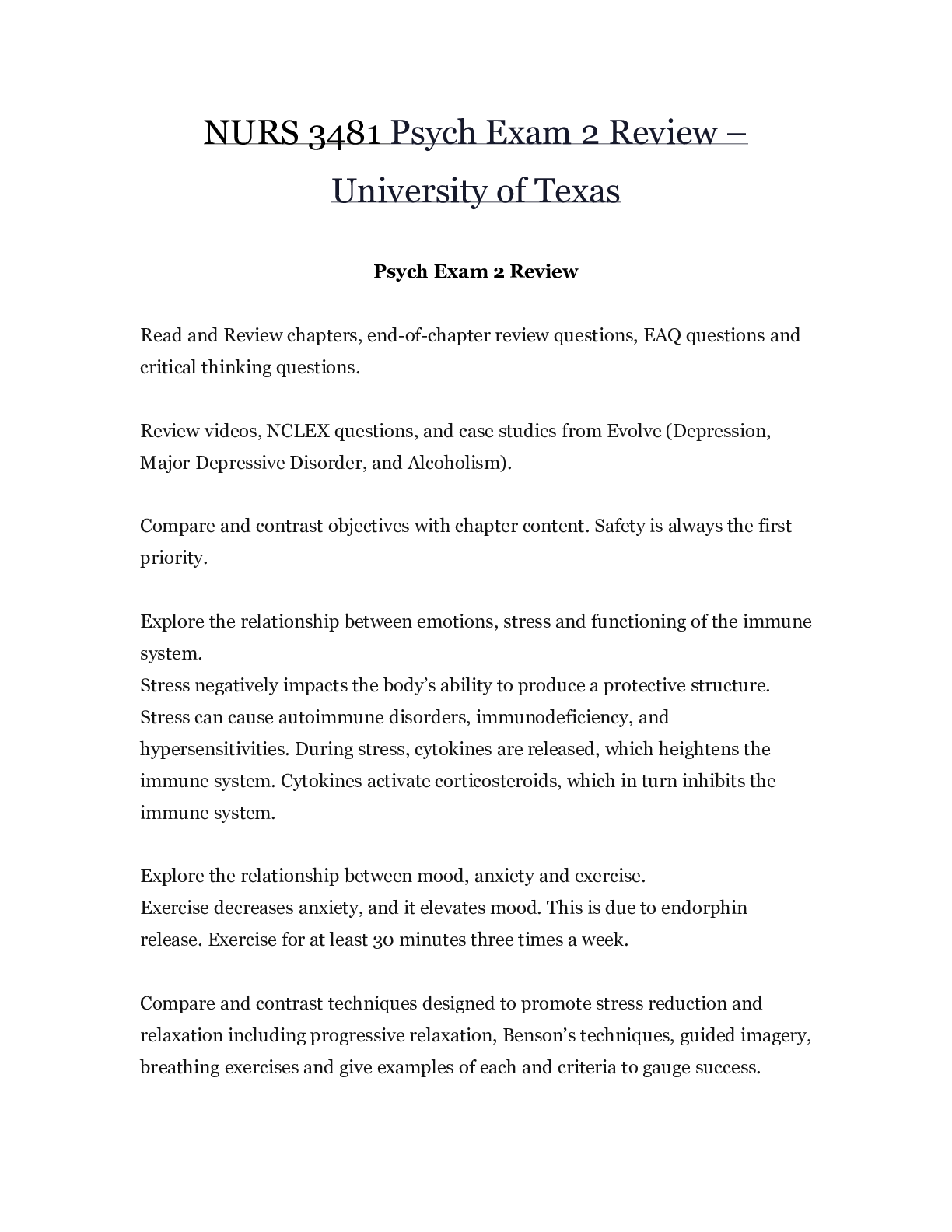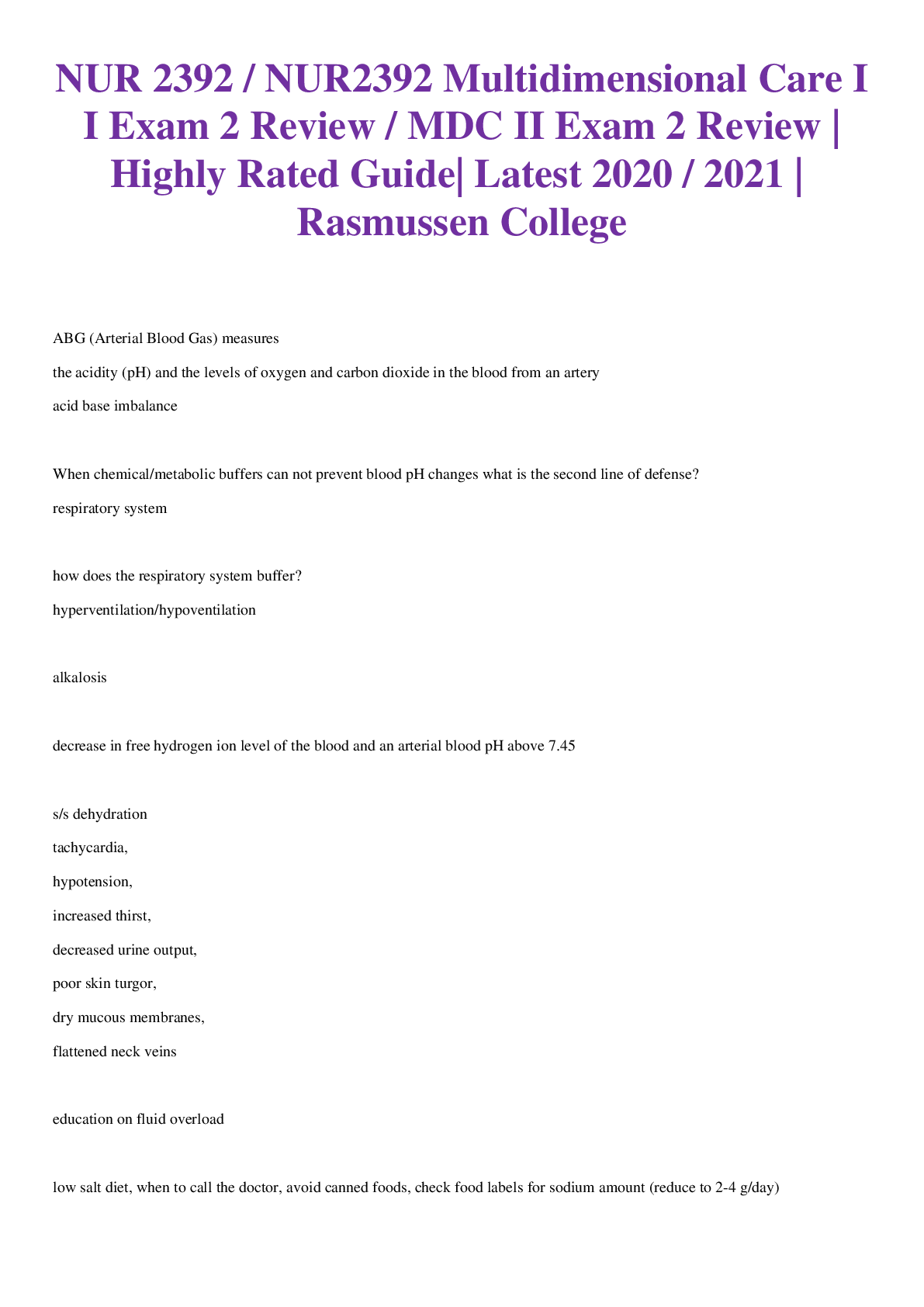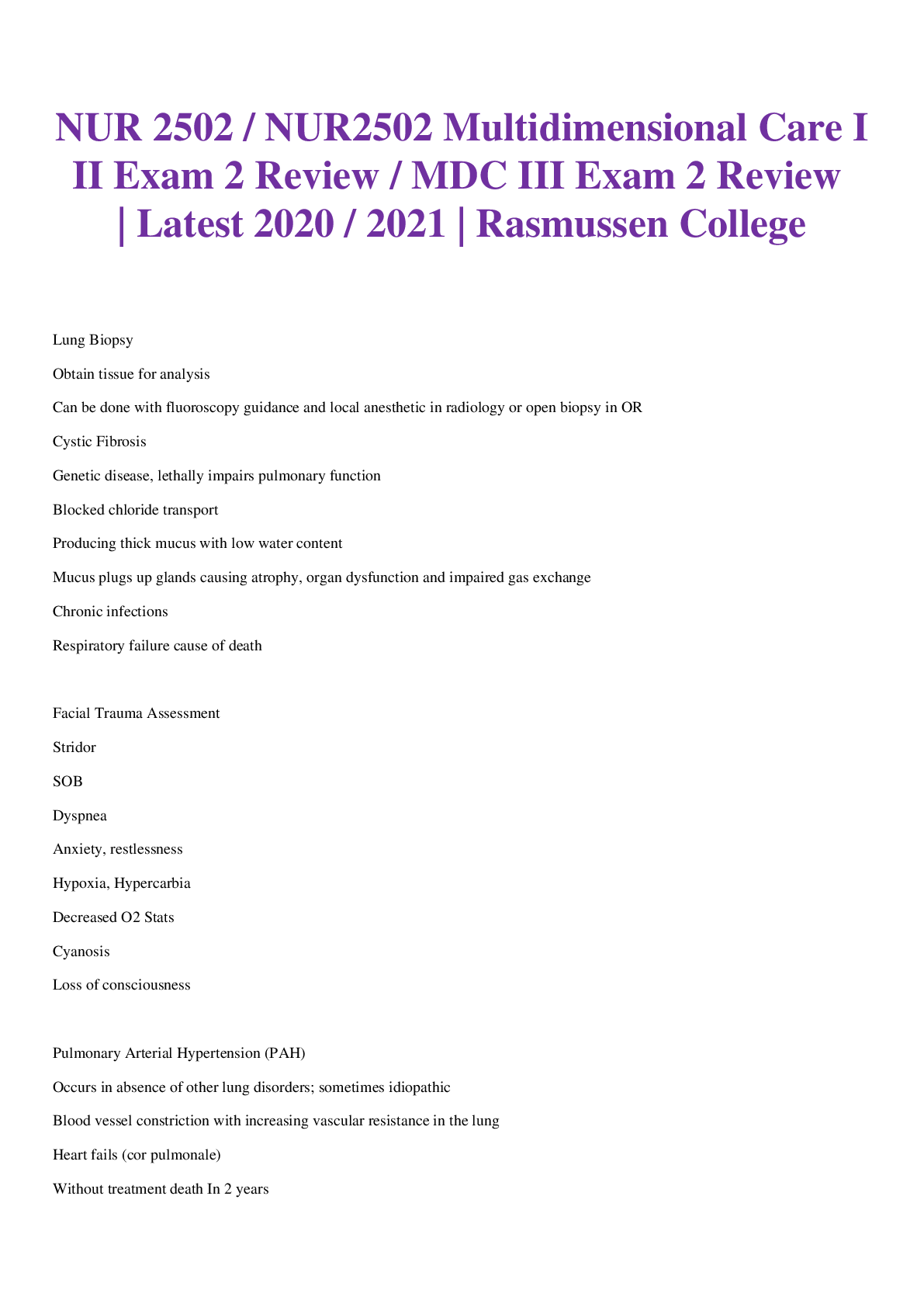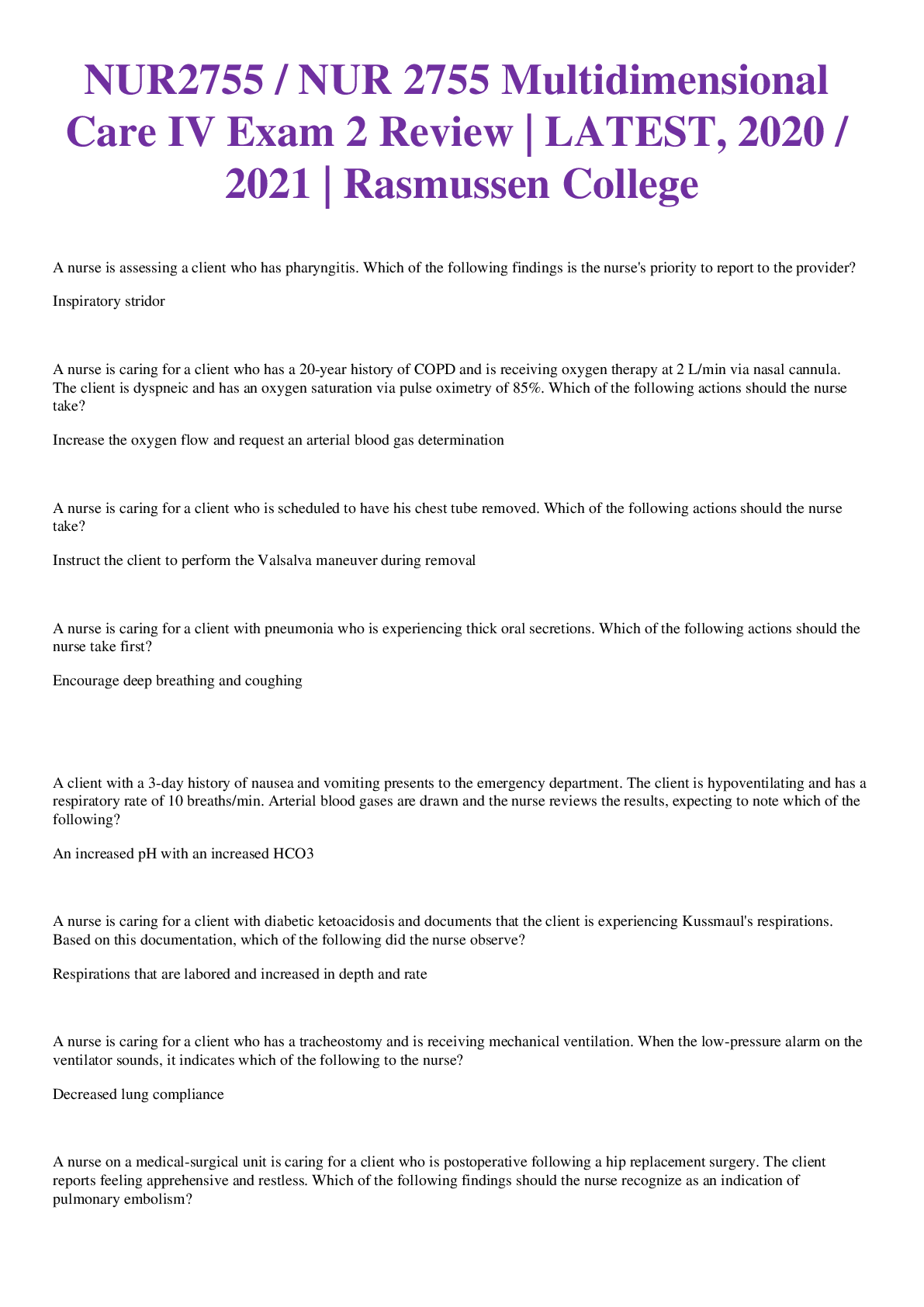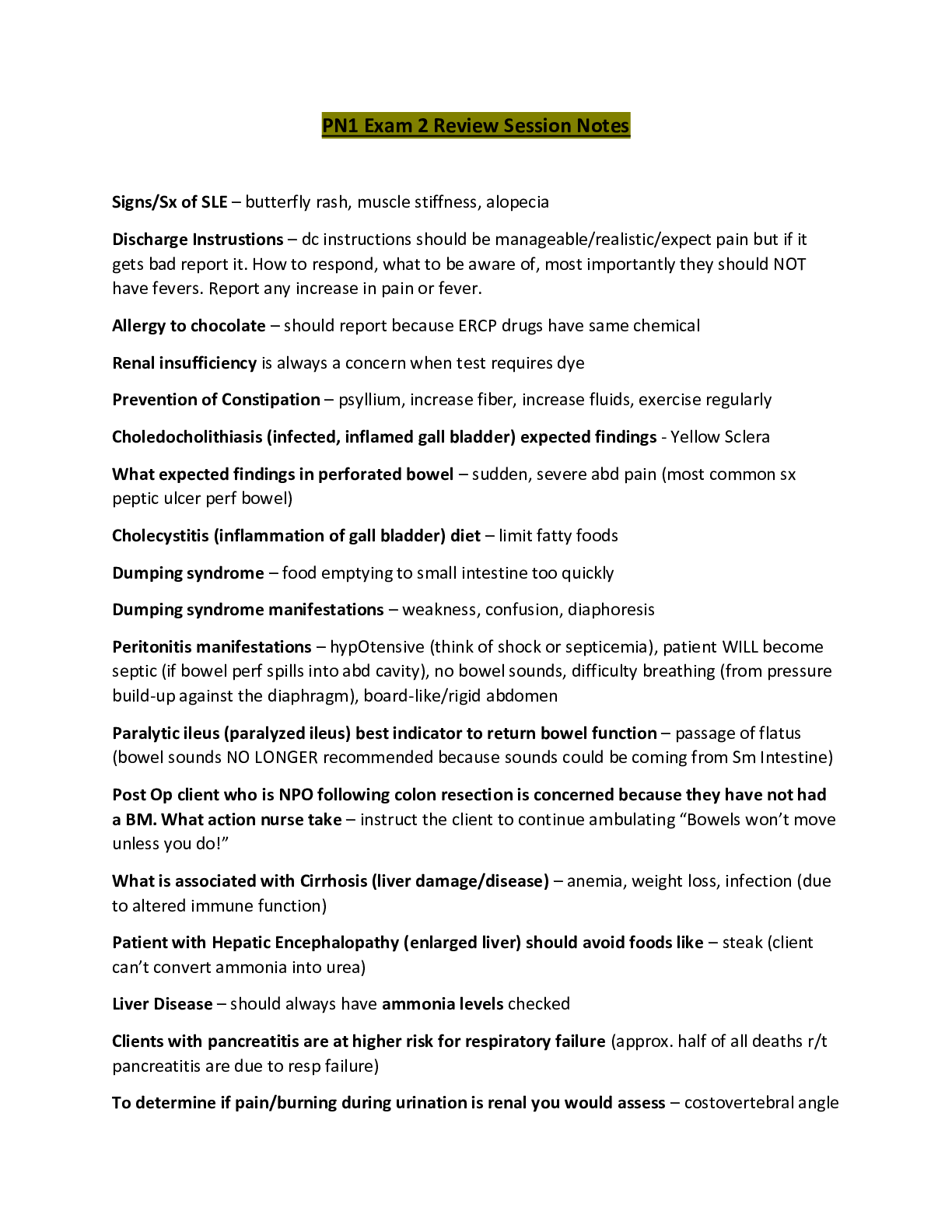NR 226: Exam 2 review questions 2/25/2021
Document Content and Description Below
NR 226: Exam 2 review questions 2/25/2021 1. A nurse suspects that an older adult may have a fluid and electrolyte imbalance. Which assessment best reflects fluid and electrolyte balance in an older... adult? - funds success, pg 369, # 6 a. Intake and output results - only fluid balance b. Serum laboratory values – fluid, electrolyte and acid-base imbalances c. Condition of the skin –only fluid balance d. Presence of tenting – only fluid balance 2. A nurse is caring for a patient with an intestinal stoma. Which intervention is most important? – funds success, pg 387, #20 a. Cleansing the stoma with cool water – not a priority b. Spraying an air-freshening deodorant in the room - not a priority c. Selecting a bag with an appropriate-size stomal opening –the opening of the appliance must be large enough to encircle the stoma to protect the surrounding tissues from intestinal discharge without impinging on the stoma and impairing circulation d. Wearing sterile nonlatex gloves when caring for the stoma 3. A nurse is caring for a patient who had an abdominal hysterectomy. Which intervention best prevents postoperative thrombophlebitis (DVT)? – funds success, pg 418, # 11 a. Utilization of compression stockings at night – promotes venous return for limited amount of time while sleeping only b. Deep breathing and coughing daily– prevents atelectasis and pneumonia c. Leg exercises 10 times per hour when awake – active intervention by patient that contracts the muscles of the legs. This rhythmically compresses the veins, which promotes venous return and prevents stasis. d. Elevation of the legs on 2 pillows – not good. Pressure is placed on popliteal space, which constricts blood vessels and impedes venous return 4. The nurse is caring for a client with a nasogastric tube that is attached to low suction. The nurse monitors the client for manifestations of which disorder that the client is at risk for? - Saunders, 8th edition, pg 116, #55 a. Metabolic acidosis – diarrhea (base out the butt), b. Metabolic alkalosis – vomiting (throw up the acid), gastric suctioning c. Respiratory acidosis - caused by hypoventilation: pneumonia, asthma, OD, airway obstruction d. Respiratory alkalosis – anxiety, acute pain, ASPIRIN OD (stimulates the brain stem respiratory control) 5. The nurse is caring for a client with several broken ribs. The client is most likely to experience what type of acid-base imbalance? – Saunders, 8th edition, pg 117, #63 a. Respiratory acidosis from inadequate ventilation – caused by hypoventilation b. Respiratory alkalosis from anxiety and hyperventilation - c. Metabolic acidosis from calcium loss due to broken bones – nothing in question re: Ca+ loss d. Metabolic alkalosis from taking analgesics containing base products – pt. not taking analgesics 6. A patient is experiencing diarrhea and needs to replace potassium. Which nutrients selected by the patient indicate that additional teaching is necessary regarding nutrients high in potassium. Select all that apply. Test success, pg 288, #30 a. Beef boullion b. Orange juice c. Poached egg d. Warm tea e. Avocados- review list in your power point: banana, sweet potato, baked potato, dried apricot 7. A 750-mL tap-water enema is ordered for a patient. Which should the nurse do to best promote acceptance of the volume ordered? Test success pg. 300, # 4 a. Administer the fluid slowly, and have the patient take shallow breaths b. Place the patient in the left lateral position, and slowly administer the fluid c. Have the patient take shallow breaths, and keep the fluid at body temperature d. Keep the fluid at body temperature, and place the patient in the left lateral position Test taking strategy: “promotes acceptance “are key words. Temperature of water does not promote acceptance. It just prevents abdominal cramping. 8. A nurse collected information from several patients. Which information indicates the patient who has the highest risk for developing diarrhea? Test success, pg 301, #5 a. Is physically active – prevents constipation b. Drinks a lot of fluid – prevents constipation but doesn’t precipitate diarrhea c. Eats whole-grain bread – high fiber diet prevents constipation d. Is experiencing emotional problems – increase intestinal motility and mucus secretion 9. Sequential compression devices (SCD), are ordered for a postoperative patient. The patient asks the nurse, “Why do I have to wear these things? Which information should the nurse include in the response to the patient’s question? Select all that apply. Test Success, pg 360, #34 a. Keeps the lower extremities warm b. Helps prevent deep vein thrombosis c. Accelerates the rate of wound healing d. Promotes circulation of blood back to the heart e. Eliminates the need for leg and foot exercises after surgery 10. A patient is admitted to the post anesthesia care unit (PACU) after abdominal surgery. The patient’s vital signs are blood pressure 150/90 mm Hg, pulse 88 and bounding, respirations 24 with some crackles. Which response does the nurse conclude that the patient most likely is experiencing? Test success, pg 415, #10 a. Hypoglycemia- fatigue, dizziness, sweating, palpatations, BS < 70 b. Hyponatremia – lethargy, confusion, anorexia, N/V, seizures, sodium < 135 c. Hyperkalemia – muscle cramps, dysrhythmias, oliguria/anuria, k > 5 d. Hypervolemia – intraoperative fluids can sometimes be excessive during surgery and cause this problem Review PPT slides with all the pneumonics you were given. Write them on your scratch paper right away so you don’t forget them. 11. A newly admitted patient reports not having had a good bowel movement in 10 days. Which questions should the nurse ask the patient to identify the possibility of fecal impaction? Select all that apply. Test Success, pg 415, #12 a. “How long has it been since you had a formed stool?” – no formed stool with impaction b. “have you had small amounts of liquid stool?” – peristalsis behind the impaction causes liquid stool c. “do you notice a bad odor to your breath?” – small bowel obstruction could cause this d. “have you been eating food with fiber?” – prevents constipation. Won’t help impaction e. “are you having any nausea or vomiting?” –usually nausea, but can cause vomiting as well 12. A nurse is caring for a postoperative client who suddenly becomes restless. The nurse should take which most appropriate action? Saunder’s strategies for test success, pg 65 a. Notify the physician – intervention. Usually nurse can do something first before calling md, unless it is an emergency b. Medicate the patient for pain – intervention, nothing in question mentions patient has pain c. Check the client’s vital signs - assessment d. Talk to the client in a calm voice – intervention Test taking strategy: priority question. Most appropriate action, what should you do first? What is most important? Patient could be going into shock. Look at each answer and label them as assessments or interventions. We know the patient is restless, but we have NOT assessed the patient yet! Answer has to be C. Answers that begin with words: ascertain, check, collect, determine, monitor, observe…. All are “assessment” answers. 13. A client scheduled for an operative procedure states to the nurse, “I am not sure if I should have this surgery”. Which response should the nurse make to the client? Saunder’s strategies for test success, pg 131, #18 a. “It is your decision” – nontherapeutic (blunt response) b. “Do not worry. Everything will be fine” – nontherapeutic (false reassurance) c. “Why do you not want to have this surgery?” – nontherapeutic (make client feel defensive) d. “Tell me what concerns you have about the surgery” – only therapeutic answer that will assist in exploring feelings Test taking strategy: this question is not really a postoperative question. It is a therapeutic communication Q 14. A nurse is caring for a client who will perform fecal occult blood testing at home. Which of the following information should be included when explaining the procedure to the client? ATI funds book, pg 249, #1 a. Eating more protein is optimal prior to testing – no red meat, fish or poultry. Can alter results b. Patient can take all of their scheduled medications, including aspirin, before obtaining specimen- per Perry and Potter, pg 1156 - 1158, you should avoid aspirin and NSAID’s 7 days prior to avoid a false-positive result c. A red color change indicates a positive test- BLUE color d. The specimen cannot be contaminated with urine 15. A nurse is assessing a client who had diarrhea for 4 days. Which of the following findings should the nurse expect? Select all that apply ATI funds book, pg 249, #3 a. Bradycardia – tachycardia due to dehydration b. Hypotension – prolonged diarrhea (4 days) c. Elevated temperature- with dehydration d. Poor skin turgor – with dehydration e. Peripheral edema 16. A nurse is collecting data from a client who is receiving IV therapy and reports pain in the arm, chills, and “not feeling well”. The nurse notes warmth, edema, redness and red streaking on the client’s arm close to the IV insertion site. Which of the following actions should the nurse plan to take first? ATI funds book, pg 304, #2 a. Obtain a specimen for culture – not priority b. Apply a warm compress – not priority c. Administer analgesics – not priority d. Discontinue the infusion – do this first to prevent further injury Test taking strategy: what do you do first/next? Priority question. These are all interventions. The nurse has already done a thorough assessment above and needs to take action Question: what is wrong with this IV? (phlebitis). What does infiltration look like? - skin taut, edema, cool to touch, blanched 17. The nurse is performing an admission assessment on a client who has hypovolemia due to vomiting and diarrhea. The nurse should not expect which of the following findings? Select all that apply. ATI Funds, pg 357, # 1 ( question has been modified) a. Flat neck veins - expected b. Thready pulse – expected (very fine and barely perceptible) c. Syncope - expected d. dark urine e. postural hypotension- with change of position 18. A nurse is receiving a laboratory report for a client indicating a potassium level of 5.2 mEq/L. When notifying the provider, the nurse should expect which of the following actions? ATI funds, pg 364, #3 a. Starting an IV infusion of 0.9% sodium chloride- you would use dextrose to promote movement of potassium from ECF to ICF b. Consulting with the dietician to increase intake of potassium- K is too high already c. Initiating continuous cardiac monitoring – EKG changes d. Preparing the patient for gastric lavage – maybe dialysis if it becomes severe Review tables 42-3 and 42-5 to review: causes of imbalance, signs and symptoms. Also PPT slides with pneumonics. 19. A nurse is collecting data from a client who has a calcium level of 10.8 mEq/L. Which of the following findings should the nurse expect? Select all that apply ATI funds, pg. 364, # 4 (modified the question slightly) a. Hyperreflexia – expect decreased or absent reflexes (with HYPOcalcemia, hyperreflexia) b. Muscle weakness- correct ( with HYPOcalcemia you have muscle spasms) c. Positive Chvosktek’s sign – with hypocalcemia d. Muscle cramps – is with HYPERkalemia e. Kidney stones Students need to create their own table or way to memorize all of these. [Show More]
Last updated: 1 year ago
Preview 1 out of 4 pages
Instant download

Buy this document to get the full access instantly
Instant Download Access after purchase
Add to cartInstant download
Reviews( 0 )
Document information
Connected school, study & course
About the document
Uploaded On
Feb 23, 2021
Number of pages
4
Written in
Additional information
This document has been written for:
Uploaded
Feb 23, 2021
Downloads
0
Views
50













